Title:Smart Pedestrian Management System
Displayed Name:Anubha Kumari
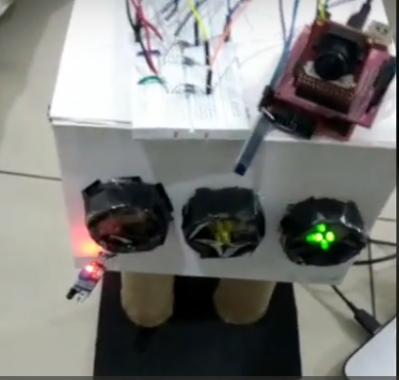
| Concept / Overview |
|---|
| The increase in the vehicles on road make the roads very congested, making it very difficult to cross the roads for pedestrians. This problem can be mitigated if the road crossings are managed based on the pedestrian density, allowing the optimal traffic flow always. The idea being proposed is to build a smart pedestrian management system that will ensure the safety of pedestrians and also allow smooth flow of traffic in absence of pedestrians, by managing the traffic light optimally. One of the major problems with most of the pedestrian crossing is that signals are not designed based on the density of pedestrians. Even when there are huge number of pedestrians the signals run for the same amount of time as when very few pedestrians are there .This disparity does not help the pedestrians as well as the traffic flow, causing situations where the signals turn green even when pedestrians are still crossing creating situations that could cause life threatening accidents. |
Introduction
In the recent times the number of vehicles on the road have seen a phenomenal rise. The increase in the vehicles on road make the roads very congested, making it very difficult to cross the roads for pedestrians. Most of the road crossings are not managed with pedestrians in mind and people crossing at such junctions can often lead to accidents. In India road accidents have become very common. The safety of pedestrians is at stake and is compromised due to crossings not managed well. When it comes to pedestrian traffic, safety should be the number one concern, but transportation infrastructure is built to accommodate vehicles, not people. This focus is putting lives at risks and the data shows it .Recent studies shows that one serious road accident in the country occurs every minute and 16 people die on Indian roads every hour. A new study suggests that the actual situation might be more serious than reflected in the official figures. The problem can be mitigated if the road crossings are managed based on the pedestrian density, allowing the optimal traffic flow always. The idea being proposed is to build a smart pedestrian management system that will ensure the safety of pedestrians and also allow smooth flow of traffic in absence of pedestrians, by managing the traffic light optimally. The traffic lights will be controlled on the basis of number of persons waiting to cross the road. The delay in traffic light will increase or decrease depending upon the pedestrian density. This system will also help visually challenged person to cross road .With the help of speaker or buzzer they will be guided about traffic timings to cross the road. This will ensure their safety.
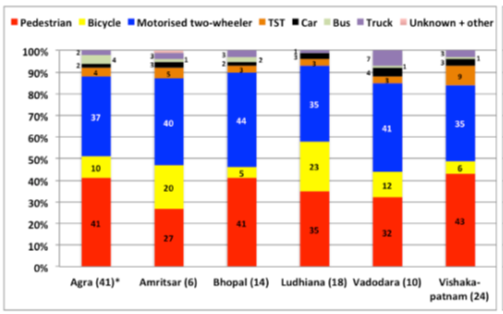
Fig. 1 Fatalities in urban cities due to road accidents
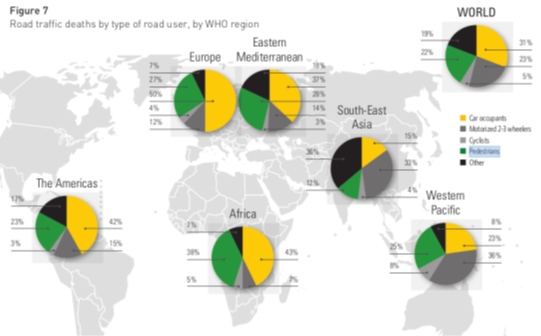
Fig.2. Road Fatalities world wide
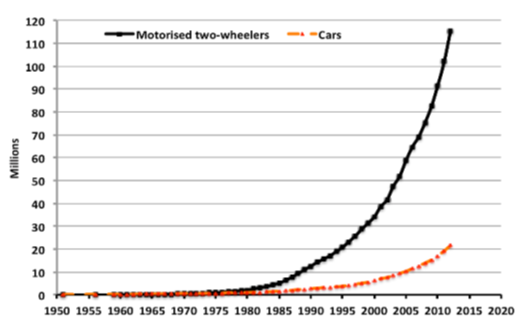
Fig. 3 No of vehicles on road
Proposed System
The idea being proposed in this project aims at creating safe signals for pedestrians as well as vehicles by ensuring that the signals are controlled optimally based on the requirements. The idea being proposed implements the following points:
- Having the signals red to provide enough time for all the pedestrians to cross
- Keeping the signals green for the traffic in cases where there are no pedestrians to cross
- Detection of vehicles which do not follow the traffic signals
- Providing an alert to the visually impaired regarding the right time to cross the road.
A)Flowchart:
The working of the system is described in the Figure below.
Pedestrians are detected using pressure pads placed on the footpaths at the curbs next to the traffic signals or at the zebra crossing points. The pressure pads will be configured to detect the number of people standing on the pads, which will be fed to a microcontroller which will communicate with the microcontroller meant to control the traffic signals. The signals will be configured to stay green as long as pedestrians are not detected avoiding unnecessary traffic stoppage.
Once even a single pedestrian is detected, the system will wait for a minimum predefined to allow any more pedestrians to join. After the minimum wait time, or if the number of pedestrians go above a predefined limit the signal will be turned red to make the traffic flow stop. The signal will remain red for a period of time enough for the detected number of pedestrians to cross. During this interval the traffic will be monitored with an IR sensor. If any of the vehicles attempt to jump the red light its image will be captured, ensuring that such culprits are punished as per the laws.
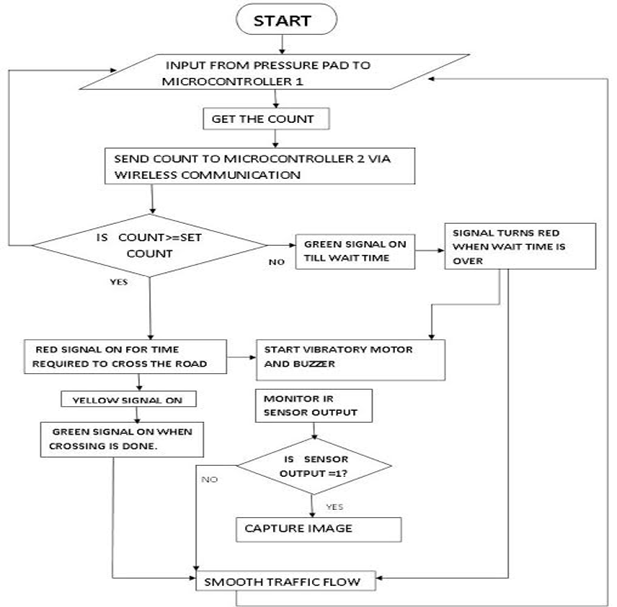
Design
- Two microcontrollers which will communicate using wireless technology like Bluetooth module Hc-05.
- Buzzers and vibratory alerts for visually challenged IR sensors
- Camera
Figure 5 given below gives the basic block diagram of the system showing the interconnection between the components.

Fig5. Block Diagram
The wireless communication between the two controllers is important to ensure that the system is adaptable to any scenario as traffic lights and pedestrian crossing zones can be present in various different orientations. There will also be a vibratory motor placed under the pads which will vibrate when it is safe to cross the road. This vibratory alert will inform all pedestrians waiting to cross about the right time for crossing.
Prototype
Figure 6 shows the prototype of the system. We can see the system in operation in figure 7.
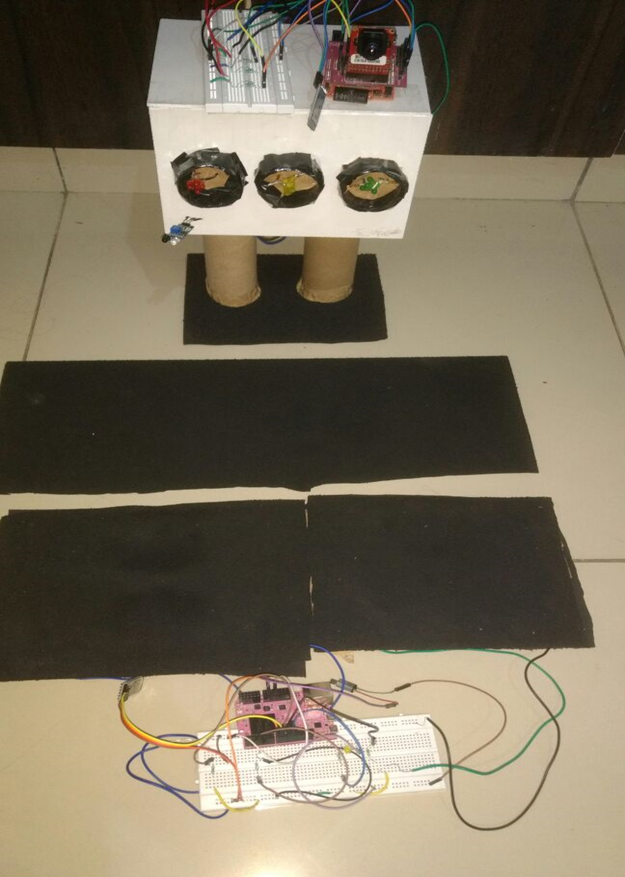
Fig 6. The prototype of the system
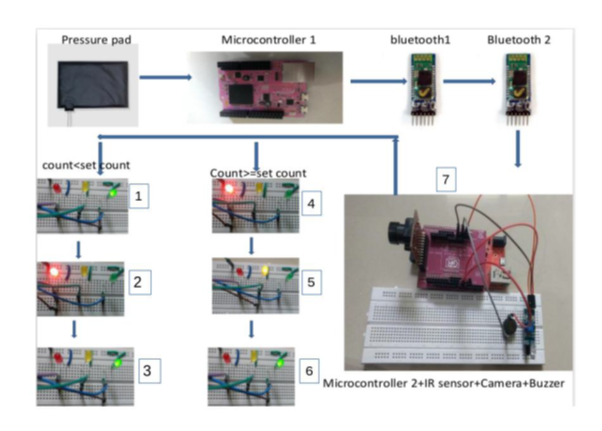
Fig. 7 Steps in Prototype
Description of Figure 7 which shows the steps of operation of the system prototype.
- If pedestrians detected are less than set count
- Block 1 : Signal is green for smooth flow of traffic
- Block 2 : Signal turns red after waiting for specified time
- Block 5: Camera takes a picture of any vehicle breaking the signal.
- Block 3: Signal turns green for traffic to flow.
- If pedestrians are more than the set count.
- Block 4: Signal turns Red as soon as count reaches the count
- Block 5: Camera takes a picture of any vehicle breaking the signal.
- Block 6: Stays red allowing pedestrians to cross, before turning yellow.
- Block 7: Signal turns green for traffic to flow
CODE
SCHEMATIC DIAGRAM
1. For main microcontroller-GR PEACH BOARD
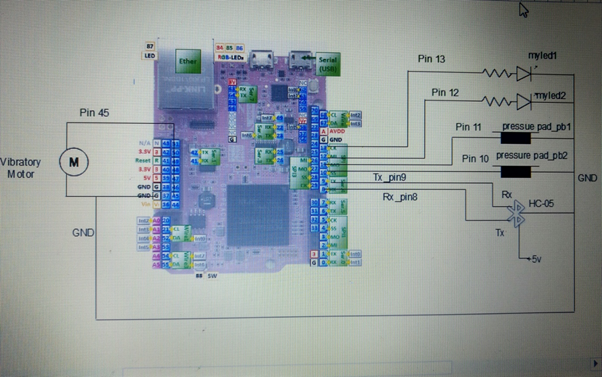
2. For microcontroller2-GR KAEDE BOARD
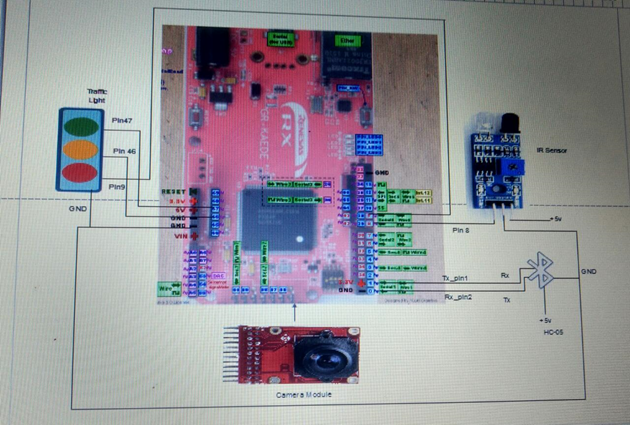
CONCLUSION
The system being proposed in this project gives a practical solution to the pedestrian crossing problems faced at the traffic signals. It also addresses the issue of ensuring a smooth traffic flow in the absence of pedestrians. If implemented successfully the system can minimize accidents at the traffic signals, saving lives and property, making the roads safer for all pedestrians.
Finalist on GR-PEACH design contest in India 2016

